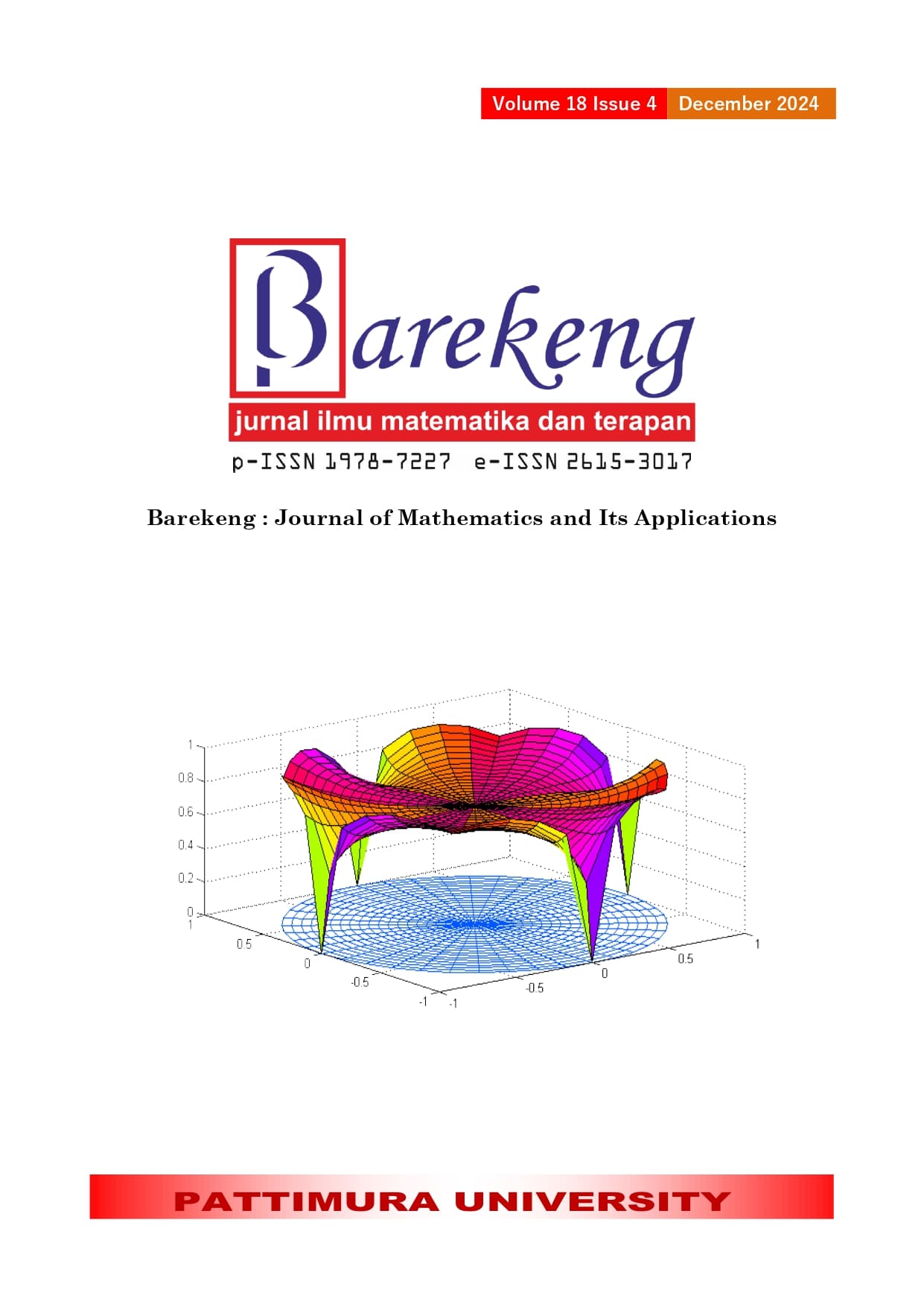DETERMINING AGRICULTURAL INSURANCE PREMIUMS USING THE BLACK-SCHOLES APPROACH BASED ON LINEAR REGRESSION OF POTATO PRODUCTION AND PRICES
Abstract
Price fluctuations, which often occur in the agricultural sector, cause farmers to experience losses when selling prices are not balanced with production costs. The government is trying to minimize farmers' losses by issuing an agricultural insurance program. One of the problems with agricultural insurance is determining the premium that farmers must pay so as not to disadvantage the insurance company. This paper explores the price of insurance premiums associated with potato cultivation in West Java, Indonesia. In addition, this research analyzes the factors that influence prices by focusing on the relationship between potato production levels and market prices. Therefore, a comprehensive data set of potato production data and associated prices is used. Regression analysis, as a statistical technique, is used to model the relationships. The Black-Scholes method then uses the obtained result to determine insurance premiums. This method is used due to a theoretical framework for pricing options that allows selecting an option's fair price using a structured, defined methodology that has been tried and tested. The premium values that depend on the trigger value are then obtained with a range of prices between IDR 5,687,670 and IDR 18,067,953 for an insured amount of IDR 39,403,000 per contract period. The premium price range allows farmers to choose the right agricultural insurance policy. It also allows insurance companies to determine insurance premiums for potato cultivation.
Downloads
References
R. Hakim, T. Haryanto, D. W. Sari, “Technical efficiency among agricultural households and determinants of food security in East Java, Indonesia,” Sci Rep, vol. 11, no. 1, p. 4141, 2021, doi: 10.1038/s41598-021-83670-7.
Saptana, A. L. Sayekti, A. D. Perwita, B. Sayaka, E. Gunawan, S. G. Sukmaya, A. D. Pitaloka, “Analysis of competitive and comparative advantages of potato production in Indonesia”. Plos one, 17(2), 2022.
M. M. Rahman, R. Nguyen, L. Lu, “Multi-level impacts of climate change and supply disruption events on a potato supply chain: An agent-based modeling approach,” Agric Syst, vol. 201, p. 103469, 2022, doi: https://doi.org/10.1016/j.agsy.2022.103469.
M. H. Filiapuspa, S. F. Sari, S. Mardiyati, “Applying Black Scholes method for crop insurance pricing,” AIP Conf. Proc, vol. 2168, no. 1, p. 20042, 2019, doi: 10.1063/1.5132469.
R. C. Merton, “Theory of rational option pricing,” Bell J. Econ. Manage. Sci, vol. 4, no. 1, pp. 141–183, 1973.
F. Black, M. Scholes, “The pricing of options and corporate liabilities,” Journal of political economy. vol. 81, no. 3, pp. 637–659, 1973.
G. Barles, H. M. Soner, “Option pricing with transaction costs and a nonlinear Black– Scholes equation,” Finance Stoch, vol. 2, pp. 369–397, 1998.
G. M. Sobamowo, “Analysis of Black-Scholes Option Pricing Differential Equations Powered by Log-Payoff function using Method of Partial Taylor Series Expansion.,” World Sci News, vol. 172, pp. 118–130, 2022.
S. Qosim, K. Dharmawan, L. P. I. Harini, "The pricing of agricultural insurance premiums based on rainfall index using mixed exponential distribution method." E-Jurnal Matematika, vol. 7, no. 2, pp. 141–147, 2018.
A. M. Anggraeni, K. Dharmawan, D. P. E. Nilakusmawati, “Penentuan Nilai Premi Asuransi Pertanian Berbasis Indeks Suhu Permukaan Menggunakan Metode Burn Analysis,” E-Jurnal Matematika, vol. 7, no. 4, pp. 322–329, 2018.
L. Chicaiza, D. Cabedo, “Using the Black-Scholes Method for Estimating High-Cost Illness Insurance Premiums in Colombia,” Innovar, vol. 19, no. 33, pp. 119–130, 2009.
A. Prabowo, S. A. Sugandha, S. Riyadi, “Penentuan Besar Premi Asuransi Pertanian Berdasarkan Hubungan Fungsional antara Produksi Padi dan Indeks Curah Hujan,” In Prosiding Seminar Nasional LPPM Unsoed, vol. 11, no. 1. 2022.
I. F. Roji, “Penentuan Nilai Premi pada Asuransi Pertanian Berbasis Indeks Iklim di Kabupaten Bogor,” Jurnal Riset Statistika, vol. 2, no. 1, pp. 67–74, 2022.
G. Marola, N. Satyahadewi, W. Andani, “Application of the Black Scholes Method for Counting Agricultural Insurance Premium Price Based on Rainfall Index in Kapuas Hulu Regency, “BAREKENG: Journal of Mathematical and Applied Sciences (Jurnal Ilmu Matematika dan Terapan), vol. 17, no. 2, pp. 0819-0826, 2023.
A. S. E. Hidayat, A. C. Sembiring, “Application of the Historical Burn Analysis Method in Determining Rainfall Index for Crop Insurance Premium Using Black-Scholes,” Journal of Actuarial, Finance, and Risk Management, vol. 2, no. 2, pp. 1-9, 2023.
R. F. Togatorop, I. M. Di Asih, T. Tarno, “Perhitungan harga premi asuransi pertanian komoditas cabai rawit berbasis indeks curah hujan dengan metode Black-Scholes,” Jurnal Gaussian, vol. 11, no. 1, pp. 77–85, 2022.
A. Golbabai, O. Nikan, T. Nikazad, “Numerical analysis of time fractional Black–Scholes European option pricing model arising in financial market, ”Computational and Applied Mathematics, vol. 38, no. 4, pp. 1-24, 2019.
N. S. Widyawati, N. Satyhadewi, E. Sulistianingsih, “Penggunaan Model Black Scholes untuk Penentuan Harga Opsi Jual Tipe Eropa,” Bimaster: Buletin Ilmiah Matematika, Statistika dan Terapannya, vol. 2, no. 1, 2013.
R. Chowdhury, M. R. C. Mahdy, T. N. Alam, G. D. Al Quaderi, M. A. Rahman, “Predicting the stock price of frontier markets using machine learning and modified Black–Scholes Option pricing model,” Physica A: Statistical Mechanics and its Applications, vol. 555, p. 124444, 2020, doi: https://doi.org/10.1016/j.physa.2020.124444.
Copyright (c) 2024 Sri Purwani, Sarah Sutisna, Rayyan Al Muddatstsir Fasa

This work is licensed under a Creative Commons Attribution-ShareAlike 4.0 International License.
Authors who publish with this Journal agree to the following terms:
- Author retain copyright and grant the journal right of first publication with the work simultaneously licensed under a creative commons attribution license that allow others to share the work within an acknowledgement of the work’s authorship and initial publication of this journal.
- Authors are able to enter into separate, additional contractual arrangement for the non-exclusive distribution of the journal’s published version of the work (e.g. acknowledgement of its initial publication in this journal).
- Authors are permitted and encouraged to post their work online (e.g. in institutional repositories or on their websites) prior to and during the submission process, as it can lead to productive exchanges, as well as earlier and greater citation of published works.






1.gif)



